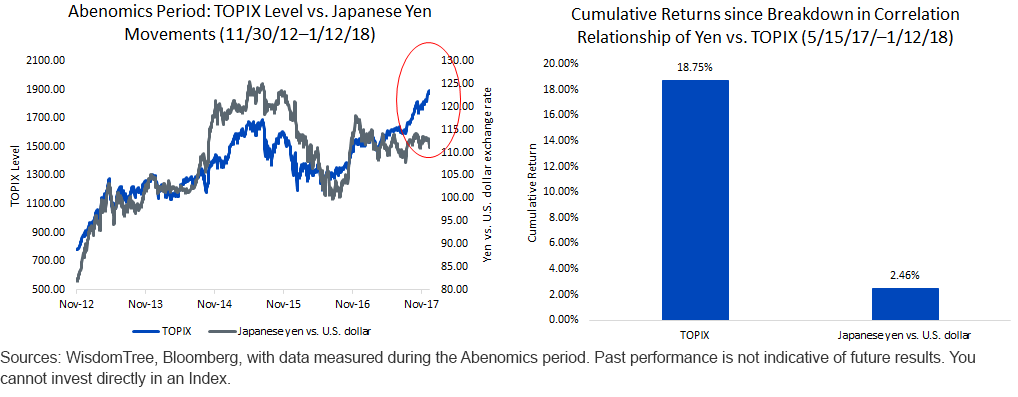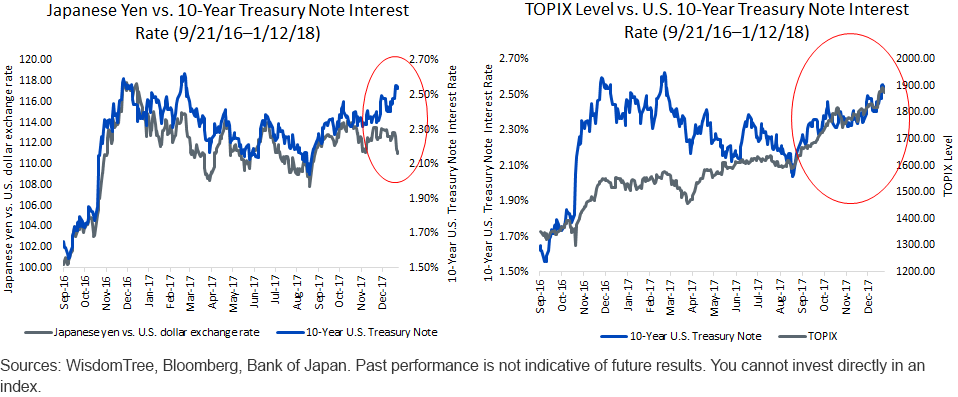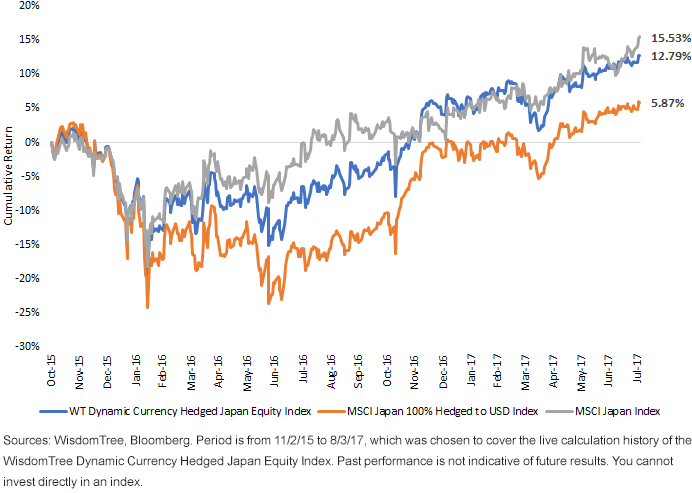New Drivers Of Japan’s Equity Performance
As we study the financial markets, we tend to search for relationships that might be connected in order to explain what’s driving returns. While it’s always exciting to find these apparent nuggets of truth, it is sometimes disheartening to recognize that—in most cases—markets will shift in future, unexpected ways, making these relationships disappear.
The relationship between Japan’s equity performance and some of these underlying drivers may be shifting along these lines.
Relationship #1: Inverse Correlation between Equity and Currency Returns
One of the most notable characteristics of Japan’s equities is that they have tended to move in the direction opposite that of the yen currency, meaning the following:
- Yen depreciation has been associated with some of the stronger equity returns we’ve seen.
- Yen appreciation has been associated with some of the weaker equity returns we’ve seen.
Looking over a long period of time, it is not yet apparent if the regime of “negative correlation” that we’ve seen largely in place since February 2007 has ended,1 but what we’ve seen recently might be an early signal that the yen’s movement is not as strongly determinant as it has been since the start of the Abenomics period.
Since May 2017, the TOPIX Has Risen While the Yen Has Strengthened!

- Since May 15, 2017, the yen has appreciated approximately 2.5% against the U.S. dollar. Normally, what we’ve seen during the Abenomics period (and prior to it during five years of yen strength) would lead us to expect lackluster or negative equity performance during such a period, yet Japan’s equities are up nearly 20% over this same period over the last seven months.
Again, we’re far from thinking that negative correlation has completely receded from view—and if there was a sharp appreciation of the currency, we’d likely see a tough environment for equities again, but divergences from past behavior like this need to be noted and monitored as we move forward.
Relationship #2: Tight Relationship between the U.S. 10-Year Treasury Note & the Yen vs. the U.S. Dollar
On September 21, 2016, the Bank of Japan initiated a policy often referenced as “yield curve control.2” A commitment was made to buy as many Japanese government bonds (JGBs) as needed to ensure that the yield of the 10-year JGB was close to zero. This was revolutionary, in that it signaled a commitment to buy a potentially unlimited amount of JGBs.
A result of this policy was that—since the yield of the 10-year JGB was now locked in due to policy—the yen became highly correlated with the level of the 10-Year U.S. Treasury note interest rate.
- A rising U.S. 10-Year Treasury note interest rate—such as around the election of President Donald Trump—was associated with a significant weakening move in the yen versus the U.S. dollar.
- A falling U.S. 10-Year Treasury note interest rate—such as in early September 2017—was associated with a significant strengthening move in the yen versus the U.S. dollar.
While the Yen Has Been Decoupling from the U.S. 10-Year Interest Rate, Japan’s Equities Have Become More Closely Correlated

- As we started 2018, we saw the U.S. 10-Year Treasury note interest rate rise above 2.5%. We can see that, in the recent past, we have expected this move to be associated with significant yen weakness—but this is not what happened. The yen has actually been strengthening in early 2018, breaking the relationship that it has had with the U.S. 10-Year Treasury note. Since this interest rate can and will move over the coming weeks and months, it will be important to see what happens to this relationship.
- Of even greater interest—and possible surprise—since the September 8, 2017, near-term bottom in the U.S. 10-Year Treasury note interest rate, Japan’s equities, as seen through the TOPIX, have become very correlated to movements in the U.S. 10-Year rate. As the 10-Year interest rate rose in early 2018, Japan’s equities responded in kind, which was not necessarily what we would have expected even one year ago. The argument is that one factor driving Japanese equities higher is an improving U.S. economy and U.S. interest rates that feed into Japanese equities that are tied to global business prospects and the U.S. economy in particular—including companies that benefit from a reduction in U.S. corporate tax rates.
Evaluating WisdomTree’s Japan Toolkit since September 8, 2017
WisdomTree has focused on three big themes within Japan.
- Exporters: This theme comes in the form of the WisdomTree Japan Hedged Equity Index; exporters normally see their strongest performance associated with a falling yen. However, we have written in the past about the potential of this strategy to respond to rising U.S. interest rates.
- Financials: This theme comes in the form of the WisdomTree Japan Hedged Financials Index, which, as we have written, is one of the least followed, but has the strongest sensitivities to rising U.S. interest rates.
- Small Caps: This theme comes in the form of the WisdomTree Japan SmallCap Dividend Index, which we also run in a currency-hedged fashion with the same equity constituents. Instead of being connected to rising U.S. rates, we have indicated that it has greater connectivity to the rising aggregate demand associated with the success of Abenomics within Japan.
WisdomTree’s Japan Toolkit Has Responded Since September 8, 2017

As investors look to understand what is happening in Japan, what happens in the U.S. economy and U.S. interest rates are of prime importance. We have established a strong link between the performance of Japanese markets with U.S. interest rates, and Japanese financials in particular have been some of the strongest beneficiaries during rising rate environments. But notice too that the Japanese exporters have also been strong performers as rates have moved higher.
While it is still too early to say the negative correlation between Japanese equities and the yen will have a much different relationship looking forward than it has over the last 10 years, the pattern at end of 2017 will bear watching throughout 2018.
1Sources: WisdomTree, Bloomberg, with data for the period 3/31/1974 –12/29/17. You cannot invest directly in an index.
2“New Framework for Strengthening Monetary Easing: Quantitative and Qualitative Monetary Easing with Yield Curve Control,” Bank of Japan, 9/21/16.
Disclaimer: Investors should carefully consider the investment objectives, risks, charges and expenses of the Funds before investing. U.S. investors only: To obtain a prospectus containing this ...
more


